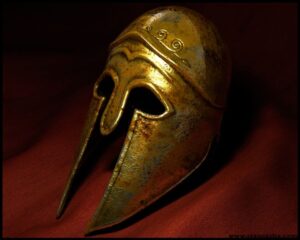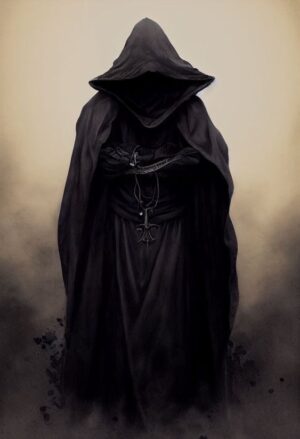Hades, the Greek god of the underworld, is associated with several symbols that represent his role and domain. Hades symbolism often depicts his connection to death, the afterlife, and the dark realm over which he rules.
Some of these symbols are specific to the personality of Hades, while others represent death and rebirth, which is associated with his realm and his mysteries.
The ancient Greeks feared many of these symbols, yet some ancient Greek cults also revered these symbols in a more metaphorical sense. Today we’ll explore both sides of Hades symbolism.
Here are some of the significant symbols associated with Hades:
Cerberus:

One of the most well-known symbols of Hades is Cerberus, a monstrous three-headed dog who guards the gates of the underworld. Cerberus symbolizes Hades’ control over the realm of the dead and his role as the keeper of souls.
Cerberus also embodies the concept of transition and liminality, serving as a guardian at the threshold between life and death. He represents the journey of the soul from the mortal realm to the afterlife, and its presence emphasizes the boundary that separates the two realms.
Cerberus symbolizes the transformative nature of death and the crossing of thresholds, of moving between worlds.
In a literal sense, the ancient Greeks feared both Hades and Cerberus. But in a metaphorical sense, especially within Greek cults, Cerberus was seen as a symbol of the crossroads. He is one of the barriers between worlds, the animal, or beast, that one most take on in order to get to the deeper realms.
The three heads of Cerberus are sometimes interpreted to represent the past, present, and future. This Hades symbolism reflects the all-encompassing nature of the underworld and its connection to the passage of time. Cerberus, with its multiple heads, signifies its awareness and dominion over all temporal aspects, from the moments that have passed to the present and the events yet to come.
Another interpretation of Cerberus’ three heads relates to the tripartite nature of human existence—body, mind, and spirit. Each head can symbolize one of these aspects, signifying the complete control Cerberus holds over an individual’s entire being, even in death. This symbolism reinforces Cerberus’ role as the guardian of souls and the overseer of their journey beyond physical existence.
Of course, the number three is incredibly powerful across cultures and religions, so it’s no surprise that we see the guardian of the underworld manifesting as a three-headed dog.
Bident:

Hades is often depicted carrying a bident, a two-pronged spear-like weapon. The bident is a symbol of his power and authority in the underworld. It is said to represent his ability to control both the spiritual and material worlds.
The bident serves as a symbol of Hades’ rulership over the realm of the dead. It signifies his control and command over the souls of the deceased, highlighting his role as the gatekeeper and judge of the underworld. The bident’s sharp prongs symbolize the power to enforce order and the ability to maintain the balance between life and death.
Symbols of Hades often coincide with the number 2 and the bident is no different. Hades is the ruler of the crossroads in some ways as he rules that space between life and death, both metaphorically and literally. The bident represents one’s power to step into these liminal crossroads.
The bident’s association with Hades, who presides over the realm of darkness and shadows, adds an element of mystery to its symbolism. It represents the enigmatic nature of the afterlife and the hidden depths of the underworld. The bident’s presence suggests that there are realms and knowledge beyond the mortal realm that are accessible only to Hades. It indicates that we only know one realm, while another remains a mystery to us.
The bident’s two prongs give it a dualistic nature. It represents the duality between life and death, the material and spiritual realms, and the forces of creation and destruction.
The bident symbolizes the simultaneous existence of opposing forces within the realm of Hades and the need to maintain equilibrium between them.
Helm of Darkness:

Another powerful symbol associated with Hades is the Helm of Darkness, also known as the Cap of Invisibility. This magical helmet was given to Hades by the Cyclops after the defeat of the Titans. It allowed him to become invisible and served as a symbol of his dominion over the hidden realm of the dead.
The Helm of Darkness is associated with shadows and darkness, which are key elements of the underworld. By donning the helmet, Hades gains control over these aspects, further solidifying his connection to the realm he governs. The darkness symbolizes the mysterious and unknown nature of death and the afterlife.
The primary Hades symbolism of the Helm of Darkness is related to its power of invisibility. When wearing the helmet, Hades becomes invisible to both mortals and gods, effectively concealing his presence and movements. This invisibility represents the elusive and hidden nature of the underworld, as well as Hades’ ability to operate undetected.
The Helm of Darkness also represents the transformative and adaptive nature of Hades. By wearing the helmet, he is able to assume a different state and move unnoticed among other gods and mortals. This transformative quality signifies Hades’ ability to navigate between different realms and adapt to different situations.
Cypress Tree:

The cypress tree is closely associated with Hades and the realm of the dead. It is often depicted in the vicinity of the entrance to the underworld. The dark and somber nature of the cypress tree represents the connection between life and death and the eternal nature of the afterlife.
In a very literal sense, the cypress tree is often found growing near graves and burial sites in the mortal world. Its presence in cemeteries and funeral rites further strengthens its association with death and the underworld. The tree’s deep roots and strong connection to the earth symbolize its link to the realm of Hades, serving as a gateway between the mortal realm and the afterlife.
The cypress tree also represents the transitional nature between life and death. In Greek mythology, it was believed that the souls of the deceased would pass through the roots of the cypress tree to enter the realm of Hades. This symbolizes the journey of the soul from the mortal world to the afterlife, emphasizing the cyclical nature of existence and the transition from one state of being to another. Here, we see a connection between Kabbalah and Greek mysticism, as many other religions also state that the root system of various trees is the entrance to the underworld.
The cypress tree is considered sacred to Hades and is often depicted as part of his domain. It is frequently shown in artistic representations of the entrance to the underworld or surrounding Hades’ palace. The presence of the cypress tree in these depictions solidifies its association with Hades and his role as the ruler of the dead.
In a way, the cypress tree represents a kind of psychopomp, or a guide to the Underworld, since the Greeks believed the trees grew both here in our world and in Hades.
Keys:

Hades is sometimes depicted holding either one or two keys, which represents his control over the gates of the underworld. He quite literally holds the keys to the door that governs life and death. This symbolizes his authority to open and close the entrance to the realm of the dead, allowing souls to enter or preventing them from leaving.
The keys also symbolize the passage and transition between the mortal world and the afterlife. They serve as a means for souls to move between realms, representing the journey from life to death and the transition to the realm governed by Hades. The keys embody the connection between the mortal realm and the underworld, emphasizing the importance of this transitional phase.
The keys associated with Hades represent the secrets and mysteries of the underworld. They serve as symbols of the hidden knowledge and wisdom that lie within the realm of the dead. The keys are the means to unlock the secrets of the afterlife, offering access to the profound mysteries and understanding of the unseen world.
More symbolically, the underworld can function as a gateway to knowledge or gnosis, so some Greek cults believed that one could only gain this gnosis by getting access to the keys of Hades.
The keys represent Hades’ ownership and possession of the underworld. They serve as a symbol of his dominion over the realm of the dead, indicating his status as the ruler and master of the underworld. The keys are a visible manifestation of his ownership, signifying his control and authority.
Overall, the Hades symbolism of the keys encompasses authority, control, passage, transition, secrets, guardianship, protection, ownership, and possession. These keys represent Hades’ role as the gatekeeper and ruler of the realm of the dead, signifying his control over the entry and exit of souls and his guardianship of the mysteries and secrets of the underworld.
The Horn Of Plenty:

In later worship, Hades was called Plouton, and his cults changed somewhat, so the symbols of Hades morphed, too. He was still feared yet he was also revered. The Romans believed that he ruled all precious metals below the ground and had the power to bestow the metaphorical cornucopia.
The primary symbolism of the Horn of Plenty is associated with abundance, prosperity, and fertility. It represents a never-ending supply of nourishment and wealth. The overflowing contents of the horn symbolize the generosity of nature, the earth’s fertility, and the abundance of resources available. In this way, Plouton is linked to the very heart of the earth itself.
The Horn of Plenty is closely linked to the concept of a bountiful harvest and agricultural prosperity. It is often associated with the autumn season and harvest festivals, representing the culmination of a successful growing season and the rewards of hard work.
So it’s not surprising that Hades is also associated with the fall season, both because it’s a spooky time when all living things around us begin to die back, and because it’s a time to reap the rewards of the harvest.
The Horn of Plenty is also associated with wealth and good fortune. It symbolizes the potential for financial and material prosperity, as well as the rewards of hard work, productivity, and wise resource management. The Romans believed that Hades had to power to bestow wealth.
Pomegranate:

The pomegranate holds symbolic significance in relation to Hades through its connection to the story of Persephone, Hades’ wife and queen of the underworld.
In the myth, Persephone was abducted by Hades and taken to the underworld to become his wife. During her time in the underworld, Persephone ate six pomegranate seeds, which bound her to the realm of the dead. As a result, she was required to spend six months of each year in the underworld, leading to the cycle of seasons—her return to the mortal realm in spring and her return to the underworld in autumn.
The pomegranate thus symbolizes the binding of Persephone to the underworld and the cycle of life and death. It represents the connection between the realm of the living and the realm of the dead, with Persephone’s consumption of the pomegranate seeds serving as a bridge between the two worlds. The pomegranate’s seeds, often depicted as blood-red, symbolize the underworld’s grasp on Persephone and her role as a queen of the realm of Hades.
As Hades’ wife and the queen of the underworld, Persephone’s association with the pomegranate extends to Hades himself. The fruit acts as a symbol of their union and the shared dominion over the realm of the dead.
Additionally, the pomegranate is also associated with fertility and abundance in Greek mythology. Its numerous seeds are seen as symbols of fertility, while the fruit itself is often associated with bounty and prosperity. This aspect of the pomegranate’s symbolism aligns with Hades’ role as the god of the underworld, where seeds planted in the earth grow into new life.
Like much of Hades symbolism, the pomegranate represents a liminal space, where one can come and go between two realms.
The Snake:

The symbolism of snakes in relation to Hades, the Greek god of the underworld, carries several associations that highlight aspects of his domain and character.
Snakes are often associated with cycles of life and death. They shed their skin, symbolizing the process of renewal and rebirth. This symbolism aligns with Hades’ role as the god of the underworld, where souls transition from life to death and potentially experience a form of rebirth in the afterlife. On a metaphorical level, they can represent Persephone’s descent in the underworld and subsequent gain of power and knowledge through rebirth each year.
In Greek mythology, snakes are sometimes associated with wisdom and knowledge. This symbolism can relate to Hades’ role as a deity with access to hidden realms and esoteric knowledge. Snakes can represent the wisdom gained from the depths of the underworld and the mysteries of the afterlife.
And not all snake symbolism is bad! Snakes have been historically associated with guardianship and protection in various cultures. In relation to Hades, snakes can symbolize his guardianship over the souls in the underworld. They serve as a protective presence, guarding the realm and its inhabitants from potential intruders or disruptions.
Snakes are often seen as symbols of transformation due to their ability to shed their skin and undergo physical changes. This symbolism aligns with Hades’ role as a deity who oversees the transition from life to death and the transformative journey of the soul. Snakes can represent the transformative nature of Hades’ realm and the potential for transcendence through the process of death.
Snakes have long been associated with the underworld and the realm of the dead in various mythologies and cultures. Their presence in the symbolism of Hades represents the deep connection between the god and his domain. Snakes are seen as inhabitants of the subterranean realm, serving as intermediaries between the mortal world and the underworld.
It’s important to note that while snakes can carry symbolic associations with Hades, they are not exclusively linked to him in Greek mythology.
Black-Robed Figure:

In artistic representations, Hades is often portrayed as a black-robed figure. The dark attire emphasizes his association with death, mourning, and the shadows of the underworld.
The black robe symbolizes death and mourning. Black is traditionally associated with mourning and grief in many cultures, representing the somberness and solemnity of loss. As the god of the underworld, Hades is closely tied to the concept of death, and the black robe reinforces this association.
The black robe also alludes to the shadows and darkness of the underworld. It signifies the hidden and mysterious nature of Hades’ realm, which is characterized by perpetual darkness. The black-robed figure serves as a visual representation of the darkness that pervades the underworld, underscoring its contrast with the light of the living world.
The black robe may also represent the concept of eternity and timelessness. Black is often associated with the absence of color or the absence of light, suggesting a void that transcends the constraints of time and the mortal realm. Hades, as the god of the underworld, exists beyond the mortal realm and is associated with the eternal nature of the afterlife.
Lastly, the black-robed figure of Hades can symbolize his separation from the world of the living. The black robe visually sets him apart from other deities and mortals, emphasizing his distinct role and domain. It highlights the boundary between the realms of the living and the dead and underscores Hades’ position as an otherworldly figure.
Narcissus Flower:

The narcissus flower is associated with the cycle of life and death. In Greek mythology, it is believed that the narcissus flower bloomed in the underworld as a result of Persephone’s connection to Hades. The flower represents the transition between life and death, the fleeting nature of beauty, and the notion of rebirth and renewal.
The narcissus flower is also associated with mourning and grief. According to some versions of the myth, while Persephone was in the underworld, her mother, Demeter, mourned her absence by refusing to let plants and flowers grow.
When Persephone was allowed to return to the mortal realm for part of the year, Demeter’s joy caused the flowers to bloom once more. The narcissus flower, which bloomed during Persephone’s absence, became a symbol of mourning for her and a reminder of the separation between the realms of the living and the dead.
However, the narcissus flower is known for its unique appearance, particularly its trumpet-shaped petals surrounding a central cup. This physical characteristic has led to symbolic associations with reflection and self-absorption. In the context of Hades, the narcissus flower represents introspection and self-reflection in the face of mortality. It encourages contemplating the cycle of life and death and the fragility of human existence.
The narcissus flower’s association with Hades stems from its blooming in the realm of the dead during Persephone’s time in the underworld. It signifies the influence of Hades over the natural world and his connection to the cycle of life. The presence of the narcissus flower in the realm of Hades underscores his association with the afterlife and his role as the ruler of the underworld.
Want to learn more about Hades? Click here for an overview of this Greek god including mythology and how to work with him.


